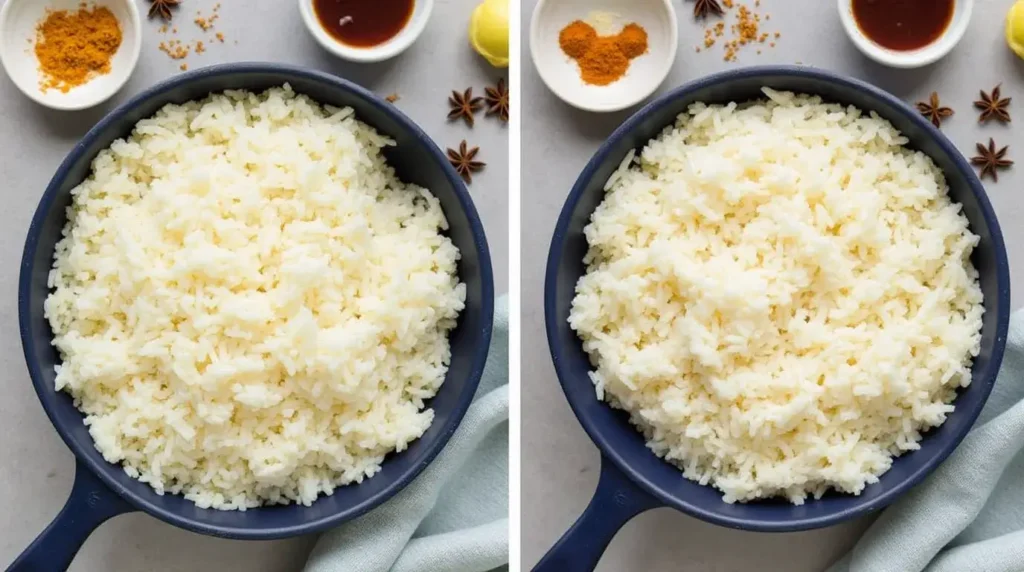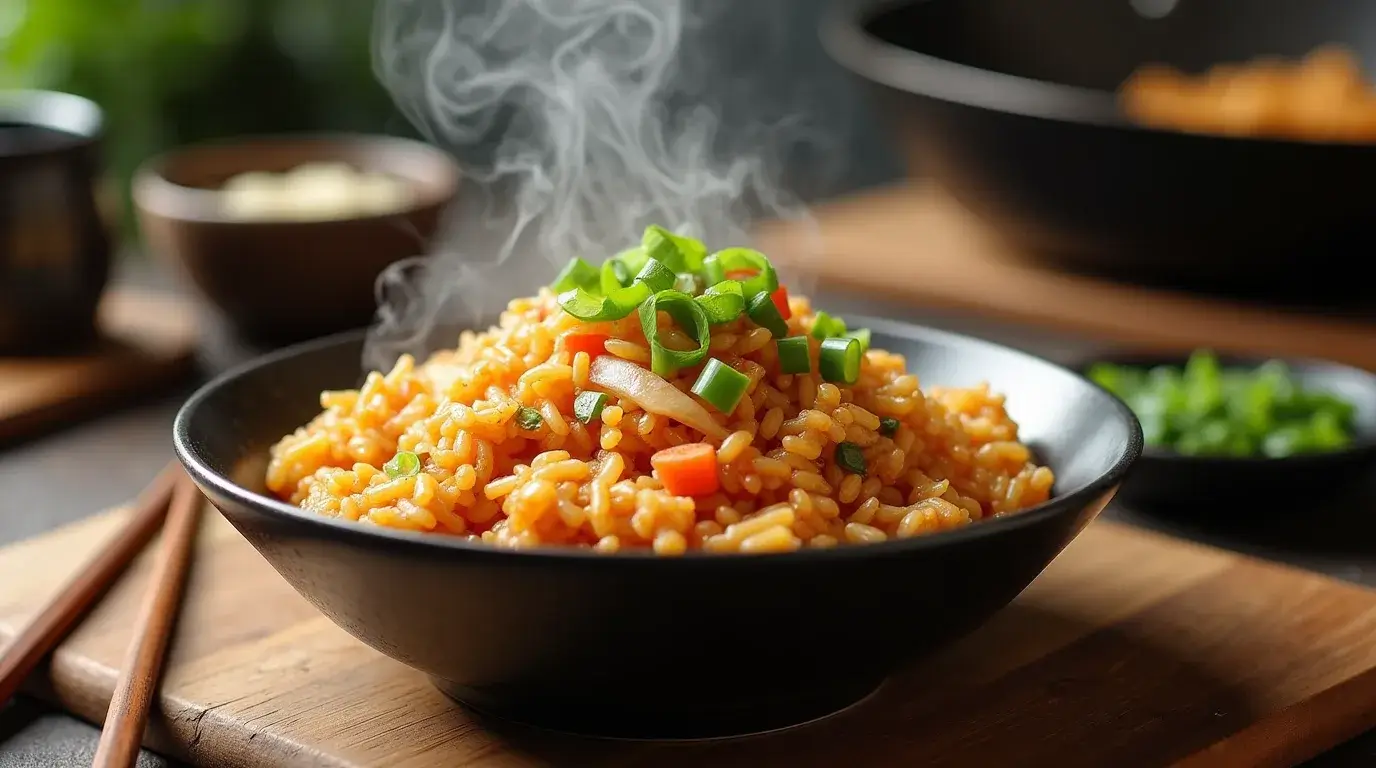Chinese fried rice isn’t just a quick meal—it’s a global favorite, celebrated for its simplicity and bold flavors. What is the secret ingredient in Chinese fried rice? Could it be the day-old rice, the aromatic oils, or maybe a special seasoning hidden in plain sight? This article dives into everything you need to know about crafting authentic Chinese fried rice, exploring the essential ingredients, cooking techniques, and regional variations. Let’s uncover what makes this beloved dish truly extraordinary.

Introduction to Chinese Fried Rice
What Makes Chinese Fried Rice Special?
Chinese fried rice has become a household favorite across the globe, renowned for its tantalizing aroma, vibrant colors, and harmonious blend of flavors. Unlike other rice dishes, fried rice balances texture and taste, combining crispy bits of rice with tender vegetables and proteins. Its versatility means you can adapt it to suit almost any palate, whether you’re a fan of spicy Sichuan-style or prefer the light touch of Cantonese cuisine.
The key to its success lies in the techniques used during preparation. Stir-frying at high heat ensures every grain of rice is coated in flavor, while quick cooking preserves the freshness of added ingredients. It’s not just food—it’s an experience.
The Global Popularity of Chinese Fried Rice
From bustling street markets in Asia to dinner tables in the West, Chinese fried rice has made its mark. Why? It’s a dish that’s both budget-friendly and endlessly customizable. You can toss in leftover day-old rice with whatever you have on hand, and voilà—you’ve got a meal that feels both gourmet and comforting.
Even though its origins are deeply rooted in Chinese culinary traditions, the dish has been embraced worldwide, adapting to regional flavors while staying true to its essence. Whether it’s infused with curry spices in India or served with a side of teriyaki sauce in Japan, fried rice showcases its global appeal as a dish that unites cultures through food.
The Key Ingredients of Chinese Fried Rice
Base Ingredient: Day-Old Rice
The foundation of every great fried rice dish lies in the rice itself. But not just any rice—day-old rice is the real game-changer. Freshly cooked rice is often too moist and clumps together during stir-frying, making it hard to achieve that signature fluffy texture. Day-old rice, on the other hand, has had time to dry out, allowing each grain to remain separate as it absorbs flavors.
What is the secret ingredient in Chinese fried rice? Some argue it’s not just the rice but how you treat it. Properly chilling rice before cooking ensures it can withstand high heat, resulting in the golden, slightly crispy grains that make fried rice irresistible.
Essential Aromatics: Garlic, Ginger, and Scallions
If rice is the body of the dish, aromatics are its soul. Garlic, ginger, and scallions are the holy trinity of Chinese fried rice, providing depth and brightness. Garlic brings a savory aroma, while ginger adds warmth and subtle spice. Scallions, with their crisp freshness, complete the flavor profile.
When cooked over high heat, these ingredients release their essential oils, infusing the rice with a rich, savory taste. Combined with other seasonings, they create a dish that’s as fragrant as it is flavorful.
The Role of Oils: Peanut Oil and Sesame Oil
Using the right oil can elevate your fried rice from good to great. Peanut oil is a common choice, prized for its high smoke point and mild nutty flavor. This makes it ideal for stir-frying at high heat without overwhelming the dish. Meanwhile, a drizzle of sesame oil at the end adds a touch of earthy, aromatic richness.
Together, these oils help create the perfect texture and enhance the overall taste, ensuring your fried rice is anything but ordinary.
Enhancing the Flavor: Soy Sauce, Oyster Sauce, and MSG
When it comes to seasoning, soy sauce is the undisputed star. Its salty, umami-packed flavor coats the rice, giving it that classic brown hue. For added depth, many cooks use oyster sauce, which combines sweetness and umami in one savory package.
And then there’s MSG—perhaps the most debated seasoning of all. This secret ingredient has been used in Chinese cooking for decades, enhancing the dish’s savory notes without being overpowering. Whether you choose to include it or not, these seasonings work together to create a balance of flavors that’s simply unforgettable.
Cooking Techniques for Authentic Chinese Fried Rice

High-Heat Wok Cooking
The hallmark of authentic Chinese fried rice is cooking it over high heat. This ensures that every ingredient cooks quickly, locking in flavors while preserving texture. A traditional wok is the best tool for the job, thanks to its rounded bottom and ability to withstand intense heat.
When people ask, “What is the secret ingredient in Chinese fried rice?” many chefs highlight the wok’s role in creating wok hei, or “breath of the wok.” High-temperature cooking allows caramelization and slight charring, producing this unique smoky flavor.
The Importance of Stir-Frying
Stir-frying isn’t just a technique; it’s an art. Constant motion is key to preventing ingredients from sticking or burning while ensuring an even distribution of heat. The result? Perfectly cooked rice with evenly mixed flavors.
This method also allows cooks to build layers of flavor. By frying aromatics first, you create a fragrant base that permeates the entire dish. Then, the rice is added, followed by seasonings and any proteins or vegetables, ensuring each bite is packed with flavor.
Breathing Technique for Fluffier Rice
A lesser-known but essential trick is to let the rice “breathe” during cooking. This means giving it a brief rest between stir-fries, allowing it to cool slightly before returning it to the wok. This process prevents clumping and ensures the rice stays fluffy.
When you combine these techniques with the right ingredients, you’ll uncover the answer to What is the secret ingredient in Chinese fried rice? It all comes down to precise techniques, attention to detail, and a touch of culinary magic.
Secret Ingredients Across Regional Variations
Cantonese-Style Fried Rice
Cantonese-style fried rice is a celebration of delicate, light flavors. Unlike some bolder regional styles, it emphasizes freshness and simplicity. The secret ingredient here could be as simple as light soy sauce or the freshness of the vegetables used. Scallions and eggs are staples, adding bursts of color and richness.
For more Chinese fried rice ideas, check out the House Special Fried Rice recipe, which provides a similar blend of nuanced flavors.
Sichuan-Style Fried Rice with a Spicy Twist
For those who crave heat, Sichuan-style fried rice delivers a kick. This variation often includes chili oil, Sichuan peppercorns, or fermented bean paste to create that iconic numbing and spicy sensation. What is the secret ingredient in Chinese fried rice here? Some might argue it’s the fermented ingredients that bring unparalleled depth to the dish.
Hokkien-Style Fried Rice with Dark Soy Sauce
Hokkien fried rice leans on darker, richer flavors, thanks to the addition of dark soy sauce. This style is heartier and often includes proteins like pork or shrimp. A splash of oyster sauce might be the hidden element that elevates the dish’s savory profile, making each bite irresistible.
For more tips on achieving the perfect flavor, visit the What Gives Chinese Fried Rice Its Taste article for additional insights into seasoning.
Tips and Tricks for Perfect Chinese Fried Rice
Using Leftover Rice for Better Texture
The cornerstone of fried rice success lies in the rice itself. Always opt for day-old rice, as it has a firmer texture that holds up beautifully during stir-frying. If you’re in a pinch, quickly refrigerating freshly cooked rice can mimic this effect.
Balancing Seasonings
Finding the perfect balance of salty, sweet, and umami flavors is essential. Soy sauce, oyster sauce, and a dash of sesame oil work together to create that authentic taste. But remember, a little goes a long way—over-seasoning can overwhelm the dish.
Incorporating Additional Aromatics Like Star Anise
Want to add a unique twist? Try adding aromatics like star anise or a sprinkle of five-spice powder. These ingredients can elevate the dish, giving it a slightly exotic and unexpected flavor.
For more delicious recipes to inspire your cooking, check out the Secret Ingredient Restaurant Fried Rice article, which dives deeper into professional techniques.

Frequently Asked Questions
What Gives Chinese Fried Rice Its Flavor?
Chinese fried rice gets its distinct flavor from a combination of umami-packed ingredients like soy sauce, oyster sauce, and sesame oil. Aromatics such as garlic, ginger, and scallions add layers of complexity, while the high-heat cooking in a wok imparts a smoky, slightly charred essence known as wok hei. Additionally, the freshness of vegetables and proteins like shrimp, chicken, or tofu enhances the overall taste, making each bite a flavorful experience.
Why Does Chinese Restaurant Fried Rice Taste So Good?
The secret behind restaurant-quality fried rice lies in their use of high heat and proper equipment, like a well-seasoned wok, which creates the wok hei flavor. Chinese chefs also rely on perfectly cooked day-old rice to achieve the ideal texture. Key seasonings, including MSG or similar umami enhancers, boost the flavor, while precise timing ensures that the vegetables and proteins retain their freshness and crunch.
What Is the Secret to Good Fried Rice in Chinese?
The secret to good fried rice boils down to three elements: technique, texture, and seasoning. Stir-frying over high heat ensures even cooking and a slightly crispy texture. Using day-old rice prevents clumping, and balancing seasonings like soy sauce, oyster sauce, and sesame oil gives the dish its signature flavor. Additionally, continuously stirring while cooking and layering aromatics like garlic, ginger, and scallions amplify the taste, making every bite delicious.
Do Chinese Restaurants Use Butter in Fried Rice?
Traditional Chinese fried rice recipes typically don’t include butter. Instead, neutral oils like peanut oil or vegetable oil are used for their high smoke points. However, some modern Chinese-American restaurants may incorporate butter to add richness and appeal to Western palates. While not traditional, the addition of butter can create a slightly creamier and richer flavor profile.
Conclusion: The Magic of Customization in Chinese Fried Rice
Chinese fried rice is a testament to the beauty of simplicity and versatility. From the essential day-old rice to the aromatic trio of garlic, ginger, and scallions, each element contributes to its irresistible charm. As we’ve seen, What is the secret ingredient in Chinese fried rice? isn’t just one thing—it’s a combination of techniques, flavors, and a little creativity.
Whether you’re making Cantonese, Sichuan, or Hokkien-style fried rice, there’s endless room for personalization. By experimenting with oils, sauces, and seasonings, you can tailor the dish to suit your taste. The secret ingredient might be as simple as using a touch of oyster sauce or adding an unexpected aromatic like star anise.
Ready to start your fried rice journey? Remember, the magic lies in the details—and a willingness to try new things. Happy cooking!


